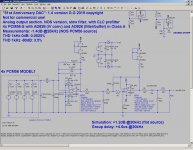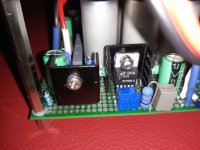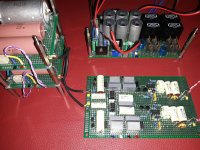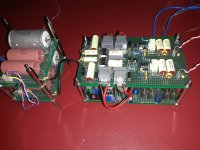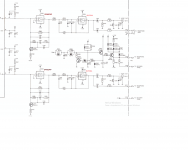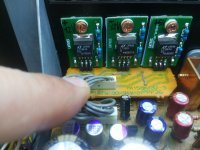Hello, few updates after some Christmas days. That is definitive and built!
1) moved from N°3 PCM56 to N°4 of PCM56 in parallel: much more current now (4.8mA) which increased dynamics at maximum levels.
2) use AD828 instead of LM6172 as IV converter: AD828 sound is impressive, simply terrific! 3D open, emotional, crystal clear and transparent: I have the singer standing now in front of me, live in the room! I've finally found something beating AD826 sound (which I'm still using as filter and cable driver! 😀). But AD828 has a BIG, HUGE problem: it is not unity gain stable! 😱 Thus I added a 47pF over the feedback resistor, plus the suggested network of Scott (56pF+100ohm).
No oscillation in real life and no on LTSpice pulse simulations (stressed tests). Listening performaces are well balanced. 🙂
3) still using the Scott input suggested capacitor, but this split as CLC network (1.2nF + 1uH + 1.2nF). Reducing L, eliminates any resonance and HF oscillations. It is tiny, I know, but DAC sounds better including it!
4) unused opamp (hence I have full separated L+R channels) modified as to have gain >2 for AD828: be advised! 😉
5) with AD828, the THD is as low as using LM6172: measured 0.0025% (0dB) on crap equipment, long wires and on tie-points contacts solderless breadboard; 3.5% (-80dB) which is really good, by using PCM56P-S (S grade is better than K grade!)
6) class A current now is working also on simulation (attached); sorry abraxalito, before not working on Sim for supply error.
7) best in class electronic components! In the attached pics there is "only" shown the output analogue section....
Well .. now I'm going to solder definitively the DAC....(8 chips...4 power supplies...mmm long work...). Some of CD vintage service manuals are giving me very good particular suggestions, not mentioned in the PCM56 datasheet....
1) moved from N°3 PCM56 to N°4 of PCM56 in parallel: much more current now (4.8mA) which increased dynamics at maximum levels.
2) use AD828 instead of LM6172 as IV converter: AD828 sound is impressive, simply terrific! 3D open, emotional, crystal clear and transparent: I have the singer standing now in front of me, live in the room! I've finally found something beating AD826 sound (which I'm still using as filter and cable driver! 😀). But AD828 has a BIG, HUGE problem: it is not unity gain stable! 😱 Thus I added a 47pF over the feedback resistor, plus the suggested network of Scott (56pF+100ohm).
No oscillation in real life and no on LTSpice pulse simulations (stressed tests). Listening performaces are well balanced. 🙂
3) still using the Scott input suggested capacitor, but this split as CLC network (1.2nF + 1uH + 1.2nF). Reducing L, eliminates any resonance and HF oscillations. It is tiny, I know, but DAC sounds better including it!
4) unused opamp (hence I have full separated L+R channels) modified as to have gain >2 for AD828: be advised! 😉
5) with AD828, the THD is as low as using LM6172: measured 0.0025% (0dB) on crap equipment, long wires and on tie-points contacts solderless breadboard; 3.5% (-80dB) which is really good, by using PCM56P-S (S grade is better than K grade!)
6) class A current now is working also on simulation (attached); sorry abraxalito, before not working on Sim for supply error.
7) best in class electronic components! In the attached pics there is "only" shown the output analogue section....

Well .. now I'm going to solder definitively the DAC....(8 chips...4 power supplies...mmm long work...). Some of CD vintage service manuals are giving me very good particular suggestions, not mentioned in the PCM56 datasheet....
Attachments
Last edited:
C575/6 (decoupling the DC bias at the DAC output) aren't giving you enough PSRR at lower frequencies in my estimation - I'd increase them to at least 100uF to be more sure of rejecting LF supply noise.
Hi! Abraxalito many thanks for your advice , are you sure ten times more?
I fear that could be a filter effect in frequency reponse.
Do you have try it?
About my personal opamps type chose what do you think?
I fear that could be a filter effect in frequency reponse.
Do you have try it?
About my personal opamps type chose what do you think?
Ten times more should be enough but I am making an assumption that the impedance of your +13.5V rail is acceptably low. If it has a (say) 22R series resistor then you should go another factor of 10 higher in capacitance I reckon.
No I haven't tried it, but I did run a simulation on LTspice. I think your opamp choices are fine for a first attempt. But I would reduce the 2n2 feedback capacitor (on the OPA627) to something considerably lower, to be judged by ear. Power supplies to this opamp are rather critical, your schematic doesn't show those.
No I haven't tried it, but I did run a simulation on LTspice. I think your opamp choices are fine for a first attempt. But I would reduce the 2n2 feedback capacitor (on the OPA627) to something considerably lower, to be judged by ear. Power supplies to this opamp are rather critical, your schematic doesn't show those.
Hello, little update, and probably final version. 😱
LM6172 IV converter is the final choiceamong more than 20 Opamps listened in that position.
Thanks to all your inputs!

Here's the reason why everybody is impressed by LM6172 at a first glance, ready to dump it in a few weeks after:Hello, few updates after some Christmas days. That is definitive and built!
use AD828 instead of LM6172 as IV converter: AD828 sound is impressive, simply terrific! .
https://www.diyaudio.com/forums/digital-source/338152-nec-cd-810-revival-mods.html#post5812138
Nobody's going all the way exploring why they actually choose to dump LM6172.It's simply the frequency loss under 100hz. With a smple RC filter you get the base back and the fatiguing highs loose their effect when all the audio bandwidth is leveled.In the Technics current bootstrap circuit this problem is even easier to spot as there's barely any input current to properly bias the power op-amp..
I suspect it's due to at least 5 x higher bias current needed than standard bipolar opamps doing the same job and i also suspect that higher current output DAC don't show this problem with LM6172.
Last edited:
- Home
- Source & Line
- Digital Line Level
- IV Opamp converter after DAC: which of the two circuits?
